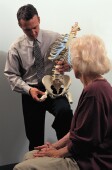
TUESDAY, April 6 (HealthDay News) — The use of complex surgical procedures to treat back pain has exploded in the past six years, even though these operations are riskier and more expensive than simpler treatments and not necessarily more effective, a study finds.
“It was a bit of a surprise to see how big the increase was,” said Dr. Richard A. Deyo, professor of family medicine and internal medicine at the Oregon Health and Science University and lead author of a report published April 7 in the Journal of the American Medical Association. “A 15-fold increase over a short period of time was more than we expected.”
Several possible explanations exist for the increase, money among them, Deyo said. “There are financial influences at play,” he said. “You get paid more for complex procedures.”
Surgery is sometimes necessary for spinal stenosis of the lower back, a narrowing of the spine that typically afflicts people over 50. Pressure on the nerves or spinal cord can cause pain. The simplest procedure is decompression, which involves removing bone fragment. It is sometimes accompanied by fusion, in which two problem bones are welded together. More complex fusion procedures can involve a variety of implants.
The study by Deyo and his colleagues looked at Medicare claims for surgical procedures for lumbar stenosis between 2002 and 2007. They found that overall the number of operations decreased slightly, from 137.4 per 100,000 Medicare users in 2002 to 135.5 in 2007, with the drop noticeable among the simpler decompression and fusion procedures.
But the rate of complex procedures rose from 1.3 per 100,000 in 2002 to 19.9 per 100,000 in 2007, a 15-fold increase.
That increase accompanied a 40 percent rise in total hospital costs for such surgery, the study found. In addition, 5.6 percent of those having complex procedures suffered complications, compared to 2.3 percent of those undergoing the simpler surgery. The likelihood of a life-threatening complication was nearly three times higher for those having a complex fusion procedure.
Patients who had complex fusions also spent an average of two days more in the hospital and had average hospital costs of $80,888, compared to $23,724 for those having simpler operations. Chances of returning to the hospital within 30 days were nearly doubled — 13 percent for those having a complex procedure, 7.8 percent for those having decompression.
The surgical literature does not appear to justify the extra cost and hazard of the complex procedures for most people, Deyo said. “Most of the evidence suggests that in terms of pain relief and functional recovery, there is not much advantage in terms of complex procedures,” he said. “There is even a possibility that the net benefit of surgery is lessened because of this.”
But many surgeons prefer to do complex procedures as a matter of pride, Deyo said. “They like to be seen as innovators.”
Also, the payoff is bigger with complex fusions, he said. The reality is that financial incentives are aligned in such a way as to favor the more complex procedures, he added. Although “many surgeons genuinely believe that more complex procedures are more advantageous,” Deyo said that view is “shaped heavily by manufacturers of surgical implants and devices.”
“The incentives are such that if there is no difference in risk to patients and people are faced with alternatives that profit them a little or a lot, a certain number of people will choose a lot,” said Dr. Eugene J. Carragee, professor of orthopedic surgery at Stanford University School of Medicine, who wrote an accompanying editorial. “It appears that the bigger operations are being done more than the pathology necessarily warrants.”
The severity of spinal stenosis has not increased over the past few years, Carragee said. “Without much change in the disease itself, the kind of operations that are being done are increasingly dangerous,” he said.
The findings should remind patients and surgeons to carefully assess the risks and benefits of various back procedures, he wrote.
A provision in the recently approved U.S. health care bill provides for studies of alternative procedures for safety and effectiveness, which could change current practice, Carragee said. But it will take years for such studies to be conducted on surgery for back pain, he noted.
More information
Learn about spinal stenosis and its treatment from the U.S. National Library of Medicine.

